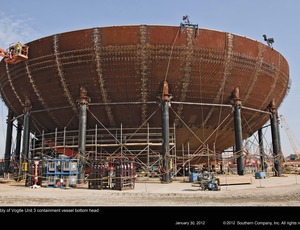
One year after the devastating March 11 tsunami and earthquake caused a nuclear crisis at the Fukushima Daiichi nuclear power station in Japan, regulators in the U.S. are working to ensure the country's fleet of nuclear reactors are safe and strong enough to withstand a natural or man-made disaster of similar force.
Numerous reports have concluded that U.S. nuclear powerplants do not pose an imminent safety threat to Americans. But at a March 13 meeting, Nuclear Regulatory Commission Chairman Gregory Jaczko said that even though the scientific and health communities have concluded that there has been minimal health impact from the crisis at Fukushima, "these kinds of accidents are not acceptable, and we have to reduce the likelihood of their occurring," he says.
To that end, on March 9, the NRC took further steps toward implementing recommendations made by an agency task force formed specifically to assess the safety of U.S. nuclear plants in light of lessons learned from Fukushima. The task force made its initial recommendations in a report released in July.
The NRC said it has instructed its staff to issue three orders to operators of U.S. commercial nuclear reactors. The directives apply to all reactors currently operating or under construction, as well as to those planned and recently licensed at the Southern Nuclear Operating Co.'s Vogtle site in Georgia.
One of those orders requires plants to provide better protection for safety equipment installed after the Sept. 11, 2001, terrorist attacks and also to obtain sufficient equipment to support simultaneously all reactors at each site.
The second order requires plants to install enhanced equipment capable of monitoring water levels in each facility's spent-fuel pool.
The third applies only to U.S. boiling-water reactors that have Mark I or Mark II containment structures. NRC is requiring those reactors to improve venting systems—or for the Mark II plants, install new systems—that help prevent or mitigate core damage in the event of a serious accident. Currently in the U.S. there are about 31 boiling-water reactors with either a Mark I or II design.
Jeff Merrifield, senior vice president of Shaw Group in Charlotte, N.C., said the required modifications will provide opportunities for his firm and others that work in the nuclear sector.
Under the second order, utilities may need to rely on engineer-procure-construct firms to assist in the design and implementation of modifications to spent-fuel pools. Under the third order, "utilities will need to engage with companies with the appropriate expertise to help them either validate the design from their existing Mark I venting system or, alternatively, assisting in the design and implementation of venting modifications," says Merrifield. Plants have until Dec. 31, 2016, to complete modifications and requirements called for under all three NRC orders.
"That's a very aggressive schedule," notes Merrifield, formerly an NRC commissioner. There are only a handful of firms with the expertise to perform the work that is required, he says. The timetable could "present challenges."
In October, the NRC set a goal of completing a rule addressing station blackouts—or loss of power—by April 2014. NRC staff currently are working on an advanced notice of proposed rulemaking to be published some time within the next year.
The commission also will issue requests for information to each operating U.S. commercial nuclear plant. Certain provisions will apply to reactors under construction or recently licensed. For example, NRC will ask operators to carry out analyses of earthquake and flooding risks using up-to-date information.
Meanwhile, an industry effort spearheaded by the advocacy group Nuclear Energy Institute is taking shape. According to NEI, under the industry's "FLEX" response strategy, companies that operate U.S. nuclear powerplants have acquired or ordered in the past year more than 300 pieces of major equipment to shore up safety.
NEI says the equipment will supplement what was already purchased following the 9/11 terrorist attacks to help facilities safely respond to large fires and explosions.
Carl Rau, president of Bechtel Group's nuclear business in Frederick, Md., says that the industry and government regulators have been working collaboratively.
"The U.S. nuclear power industry has been very proactive in response to the Fukushima event. The chief nuclear officers of our nuclear utilities worked collaboratively to define and purchase equipment and components to have available for emergency use," he says.
In addition, he says NEI has worked with the NRC to help ensure that recommendations and regulatory requirements resulting from Fukushima are both robust and practical.


Post a comment to this article
Report Abusive Comment